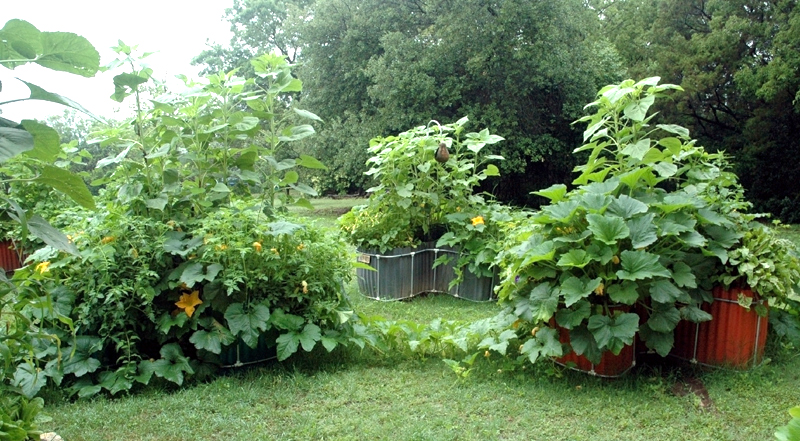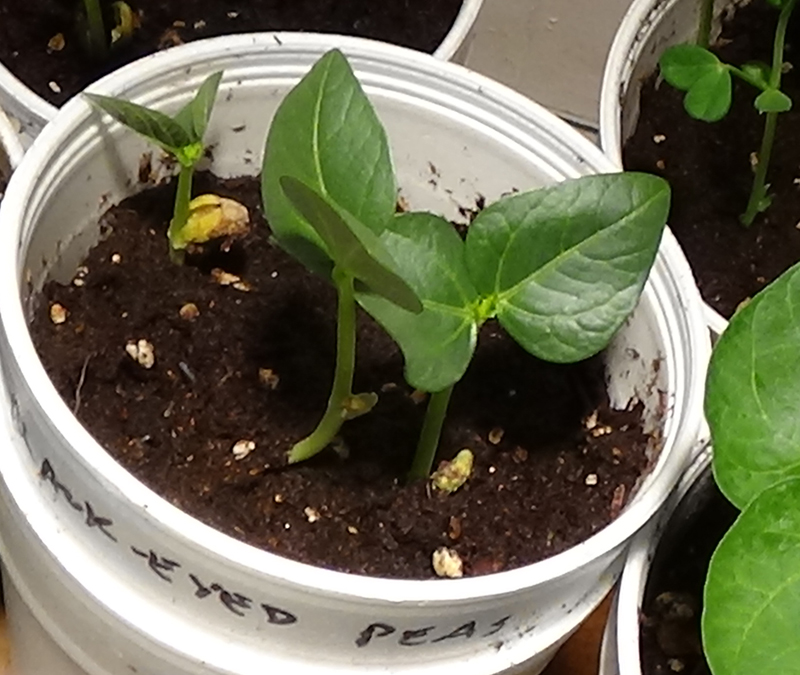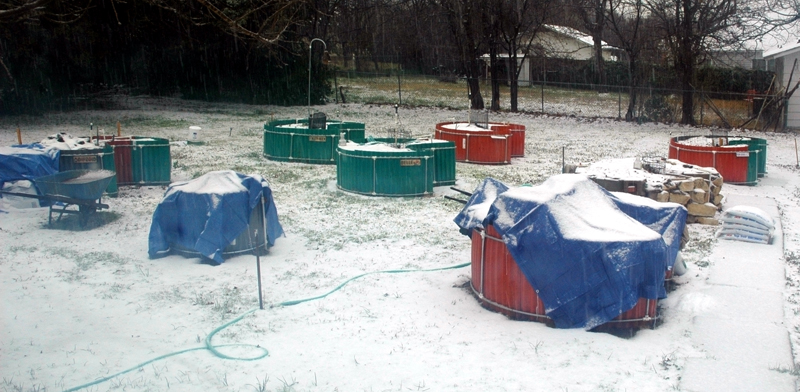 This year, I am trying to get a head start on spring by germinating some seeds in advance. Usually most of my 11 keyhole gardens are planted with seeds, probably 85 percent. The top two images were taken last May, with the gardens in grand growth. I am wanting to be able to take that same photograph this April, a little earlier, by utilizing more transplants.
This year, I am trying to get a head start on spring by germinating some seeds in advance. Usually most of my 11 keyhole gardens are planted with seeds, probably 85 percent. The top two images were taken last May, with the gardens in grand growth. I am wanting to be able to take that same photograph this April, a little earlier, by utilizing more transplants.
 We have been dealing with abundant freezing periods this year (bottom photo), although I have already planted a few things, such as onions, in about four of the gardens.
We have been dealing with abundant freezing periods this year (bottom photo), although I have already planted a few things, such as onions, in about four of the gardens.
Each year, I try to germinate seeds for an advance impact on the gardens. The results have been very sporadic and not very successful, until this year when I substituted carbonated water for regular water in the “paper towel, zipper bag” technique. Some seeds germinated within 24 hours and others took a little longer, but not the many days or weeks I had experienced in the past. When these germinated seeds were transplanted into a container with potting soil, they tended to grow very fast, as well, and looked extremely healthy.
 Here are some random photos of some of the plants in their containers (click on images to enlarge). The ones in the yellow tubes are tomatoes (four days to germinate). In other containers are, at random, sunflowers (five days to germinate), pinto beans (24 hours to germinate), black-eyed peas (24 hours to germinate), pumpkin (24 hours to germinate), and many, many more, including the seeds from a lemon (30 hours to germinate), and a bois d’arc tree (five days to germinate). I have numerous varieties that also germinated quickly and successfully.
Here are some random photos of some of the plants in their containers (click on images to enlarge). The ones in the yellow tubes are tomatoes (four days to germinate). In other containers are, at random, sunflowers (five days to germinate), pinto beans (24 hours to germinate), black-eyed peas (24 hours to germinate), pumpkin (24 hours to germinate), and many, many more, including the seeds from a lemon (30 hours to germinate), and a bois d’arc tree (five days to germinate). I have numerous varieties that also germinated quickly and successfully.
 At Keyhole Farm, we try to experiment with a few new crops each year to get an idea of how they will grow in controlled soil with the added enhancements attributed to use of the internal basket and the garden itself as a type of mound (such as for watermelons and pumpkins).
At Keyhole Farm, we try to experiment with a few new crops each year to get an idea of how they will grow in controlled soil with the added enhancements attributed to use of the internal basket and the garden itself as a type of mound (such as for watermelons and pumpkins).
Now, to think out loud, this is what I am considering for this spring. Last year I planted corn in one-half of a keyhole and beans in the other half. Both did well. Now, corn uses a lot of nitrogen from the soil and beans tend to put nitrogen back in.
 After the plants were pulled, I stirred up the soil, combining both sides. This year, however, I think I will plant a row of beans, a row of corn, a row of beans, etc. so that the give and take on the soil works more in unison, perhaps at the same time. This could result in a marked enhancement to both crops as they move toward harvest.
After the plants were pulled, I stirred up the soil, combining both sides. This year, however, I think I will plant a row of beans, a row of corn, a row of beans, etc. so that the give and take on the soil works more in unison, perhaps at the same time. This could result in a marked enhancement to both crops as they move toward harvest.
I also think I will attempt to plant a few trees in some of the keyholes to see how they do, which is the reason for the lemon and bois d’arc seeds. I am particularly interested in bois d’arc because this is one of the hardest woods in existence and is highly sought-after (and expensive). There might be advantages to a keyhole version that will speed up the growth of such plants. I also want to plant a mulberry tree in one of my keyholes.
 Since ebola drugs are grown in tobacco leaves which are in short supply, I thought I would experiment with this plant, as well, mainly to determine if keyholes provide an edge in the speed of growth. Tobacco leaves tend to grow fairly fast, but what if they grow faster in keyholes? I will keep a time log on this just to see.
Since ebola drugs are grown in tobacco leaves which are in short supply, I thought I would experiment with this plant, as well, mainly to determine if keyholes provide an edge in the speed of growth. Tobacco leaves tend to grow fairly fast, but what if they grow faster in keyholes? I will keep a time log on this just to see.
I also plan to plant some red spring wheat this year in a keyhole. Wheat takes considerable time to reach harvest. What if keyholes speed this process? Again, I will keep a time log.
Of course, I will be planting my usual crops like a variety of beans and peas, lettuce, Swiss chard, spinach, broccoli, potatoes, okra, pumpkins, watermelons, cantaloupe, cucumbers, carrots, tomatoes, peppers (hot and bell), plus a lot more.
I am looking forward to a very successful season this year with my keyhole farm and hope you will do the same with yours. In my last post I mentioned two books that every gardener and modern-day back yard farmer should read, Eat Your Greens and The Third Plate. There are ways to get even more out of your keyhole gardens than I ever imagined and these books solidly touch on the subject. Germination of seeds is also touched upon in my book, “Plant Your Garden In A Keyhole.”
 They also go extensively into one component that is often overlooked, which is choosing the right harvest time. Most veggies offered in stores are picked with shelf life as their goal. The problem with this is that time in the field when crops get a very high percentage of their nutritional values from the soil is cut short as is quite often taste. With crops you grow yourself, you can wait until the optimum time to pick, when these nutritional and taste values are at their peak, and therefore are better for you…plus they are fresher and without the possibility of pesticides being on them. This is a very important advantage to keyhole gardening.
They also go extensively into one component that is often overlooked, which is choosing the right harvest time. Most veggies offered in stores are picked with shelf life as their goal. The problem with this is that time in the field when crops get a very high percentage of their nutritional values from the soil is cut short as is quite often taste. With crops you grow yourself, you can wait until the optimum time to pick, when these nutritional and taste values are at their peak, and therefore are better for you…plus they are fresher and without the possibility of pesticides being on them. This is a very important advantage to keyhole gardening.